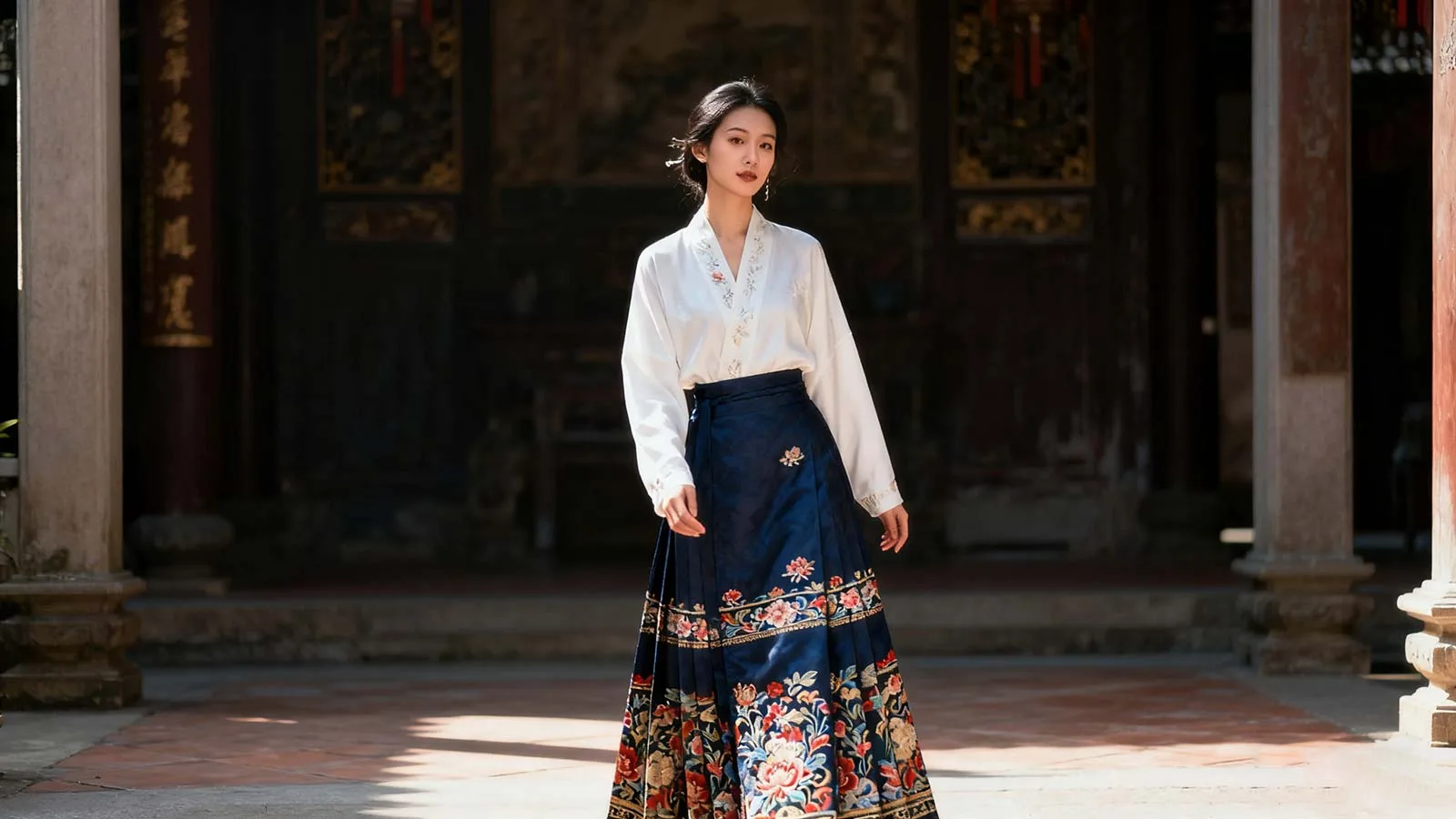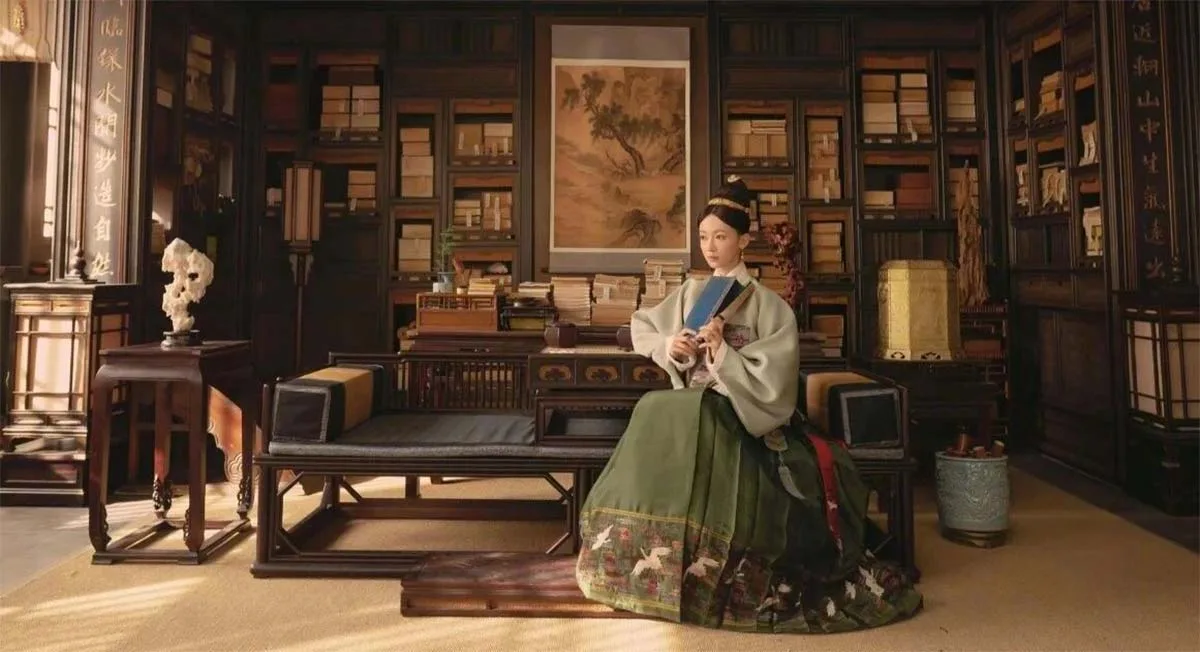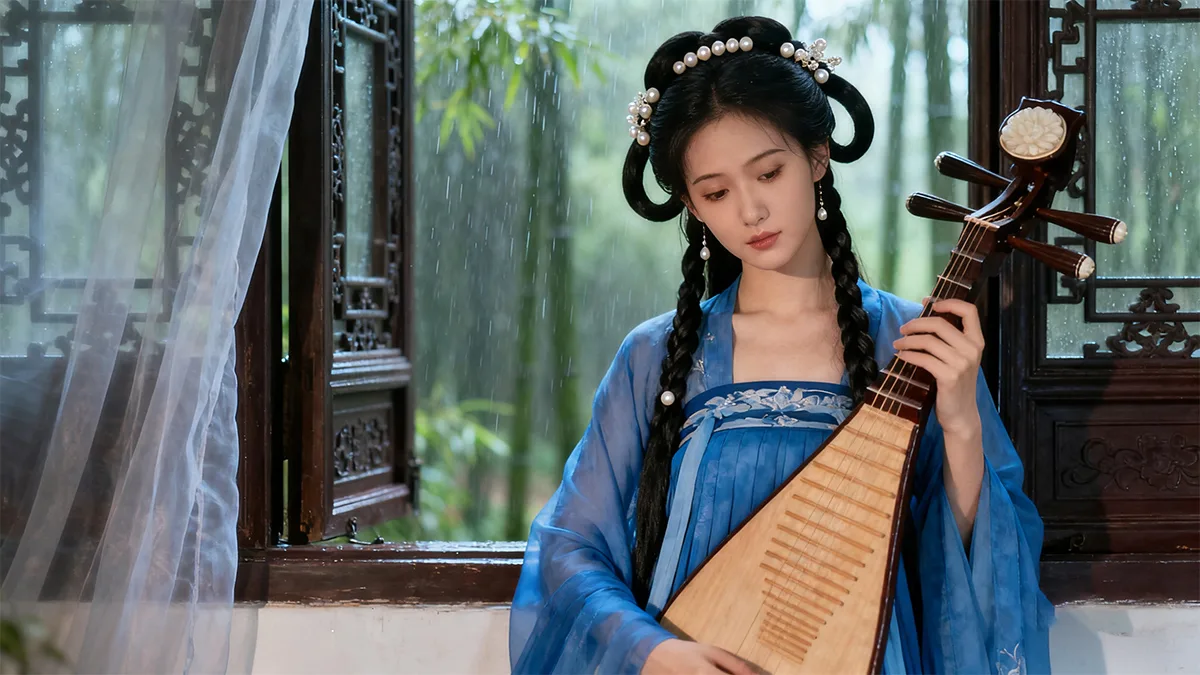What is Mamian Skirt?
Since the beginning of this year, the popularity of the mamian skirt has been undeniable.
With celebrities such as Yang Mi and Guan Xiaotong wearing mamian skirts on gala shows to showcase the cultural beauty of traditional attire, this garment—evolved from the swirling skirts of the Song Dynasty and celebrated as a signature piece of the Ming-style Hanfu system—has quickly risen to fame as a “festival battle robe.” Today, it has seamlessly made its way into a wide variety of everyday occasions
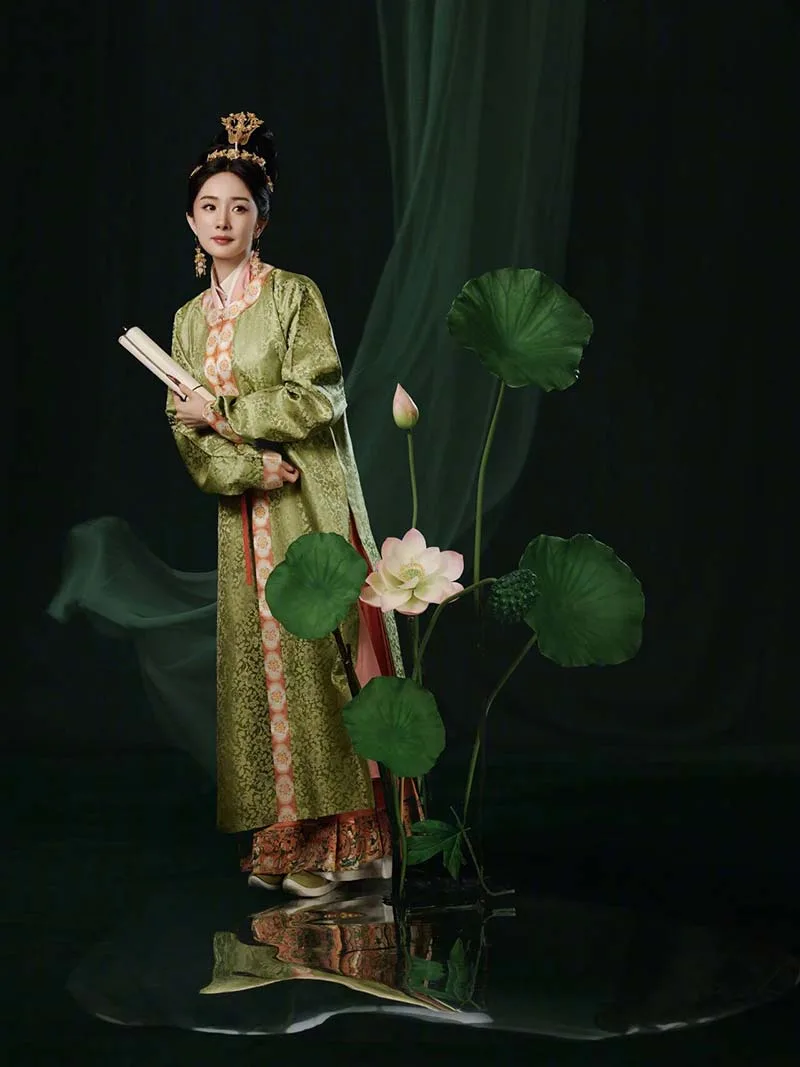
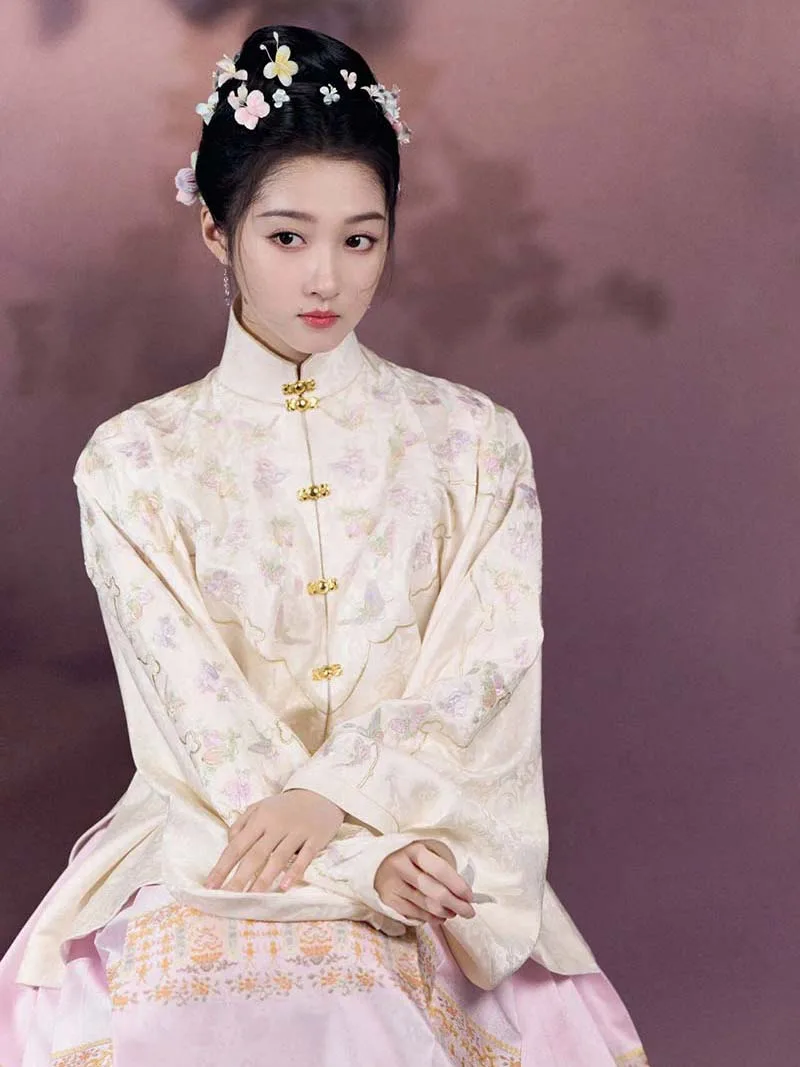
Qn the business side, the mamian skirt is no longer confined to the Hanfu category alone. Instead, it has become a phenomenon-level bestseller driving Hanfu into the mainstream, even inspiring dedicated product sections of its own.
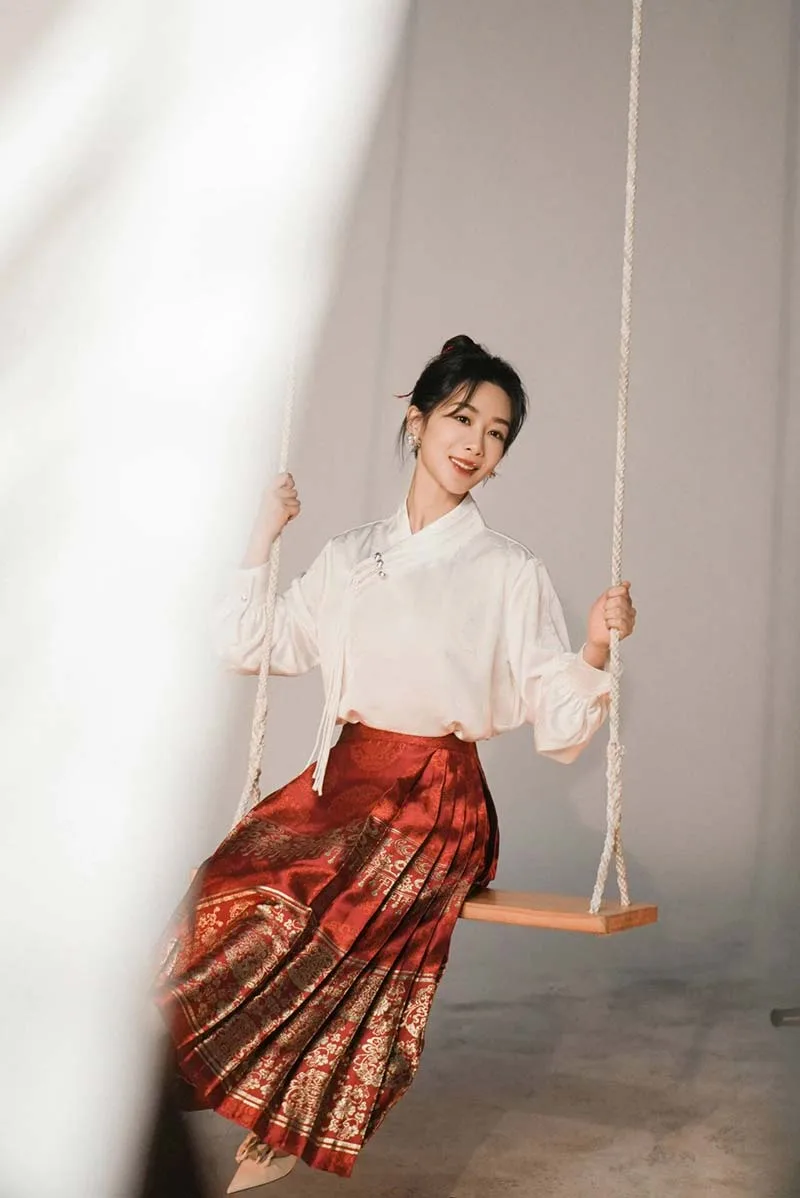
In the past, Hanfu often carried a sense of distance—an enduring beauty that seemed to exist only in dust-laden epics or historical dramas on screen, appreciated and preserved by only a small circle of devoted enthusiasts.
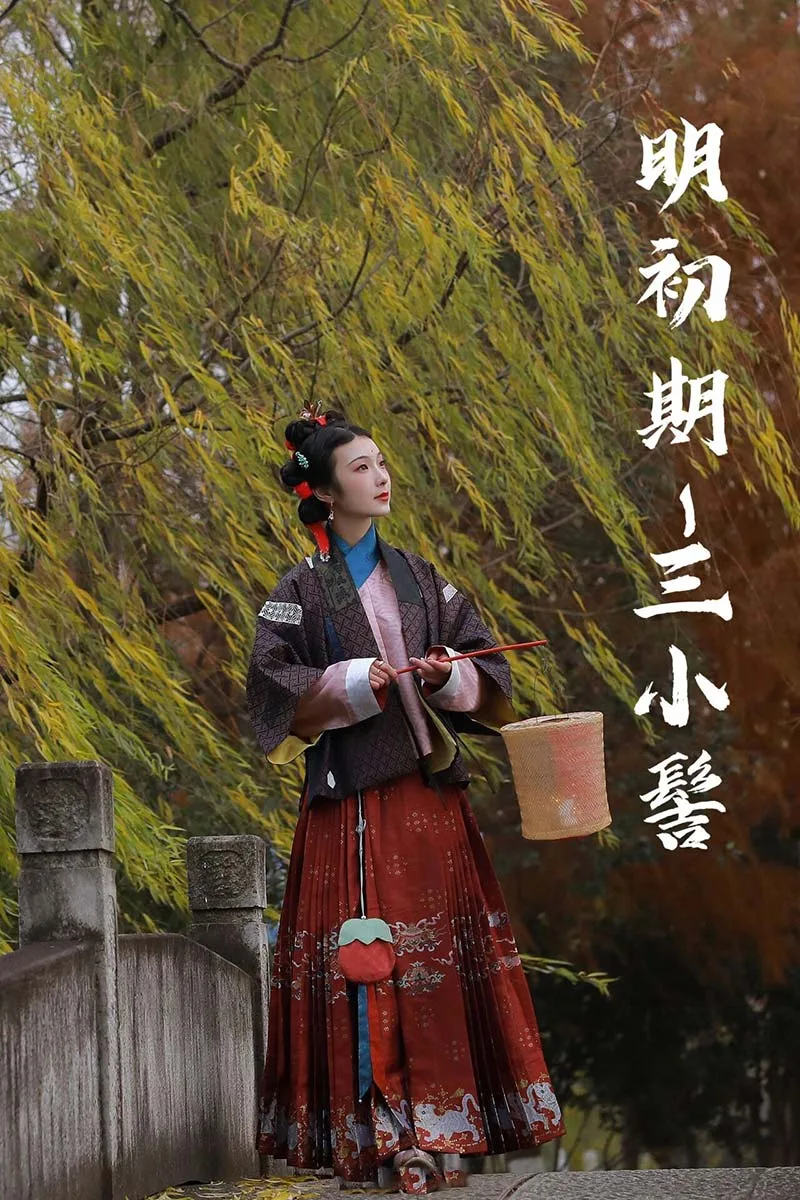
Nowadays, this splendid dress that has been around for a hundred years and was once covered in dust has, with its graceful and elegant skirt, initiated a transformation in humanistic aesthetics, commercial supply, and even the concept of inheritance.
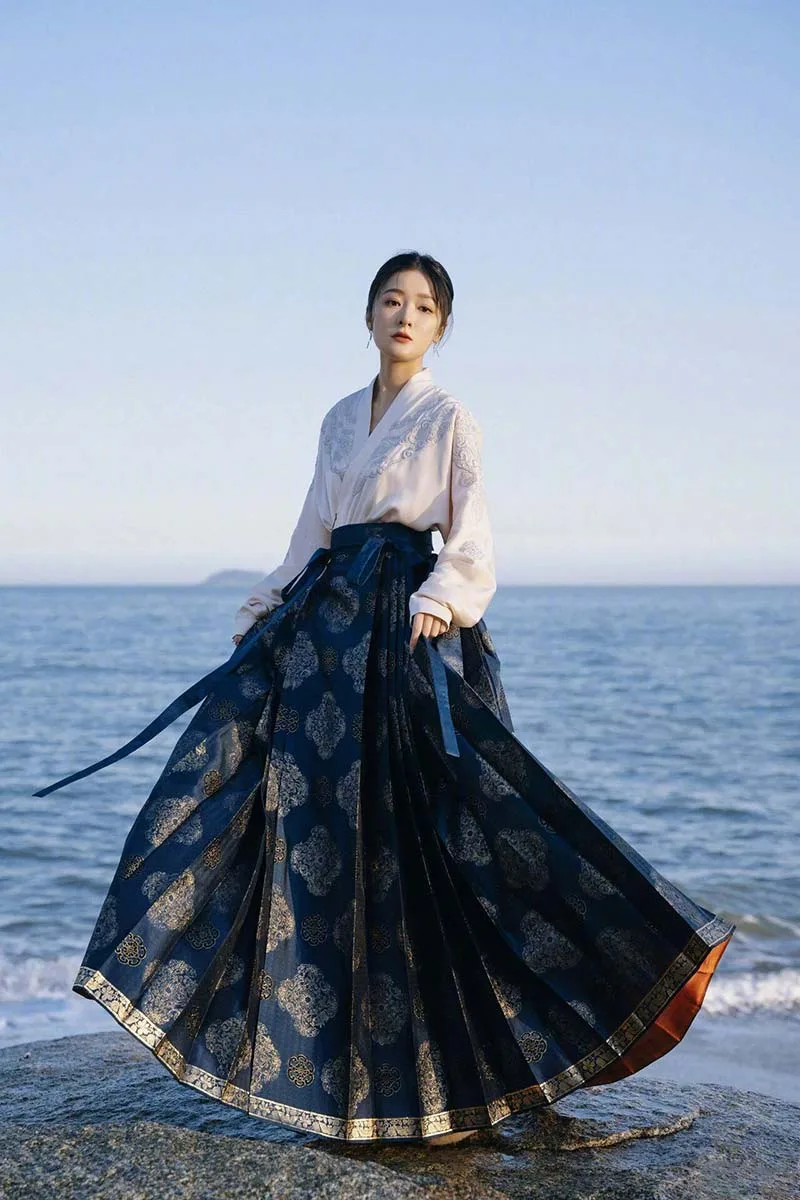
Why has the mamian skirt managed to break out from the many styles of Hanfu? The answer goes far beyond simply being a “celebrity favorite.”
The rise of the mamian skirt is part of the broader Hanfu boom in recent years.
When we talk about Hanfu, it doesn’t simply refer to clothing from the Han Dynasty. Rather, it represents the traditional attire of the Han people, emphasizing its cultural and ethnic roots. Among the various dynasties, relics of Ming-era Hanfu have been preserved in greater numbers and in better condition, providing a rich foundation for historical study. For anyone stepping into the world of Hanfu, the Ming style is an unavoidable starting point—and the mamian skirt stands as its most iconic piece.
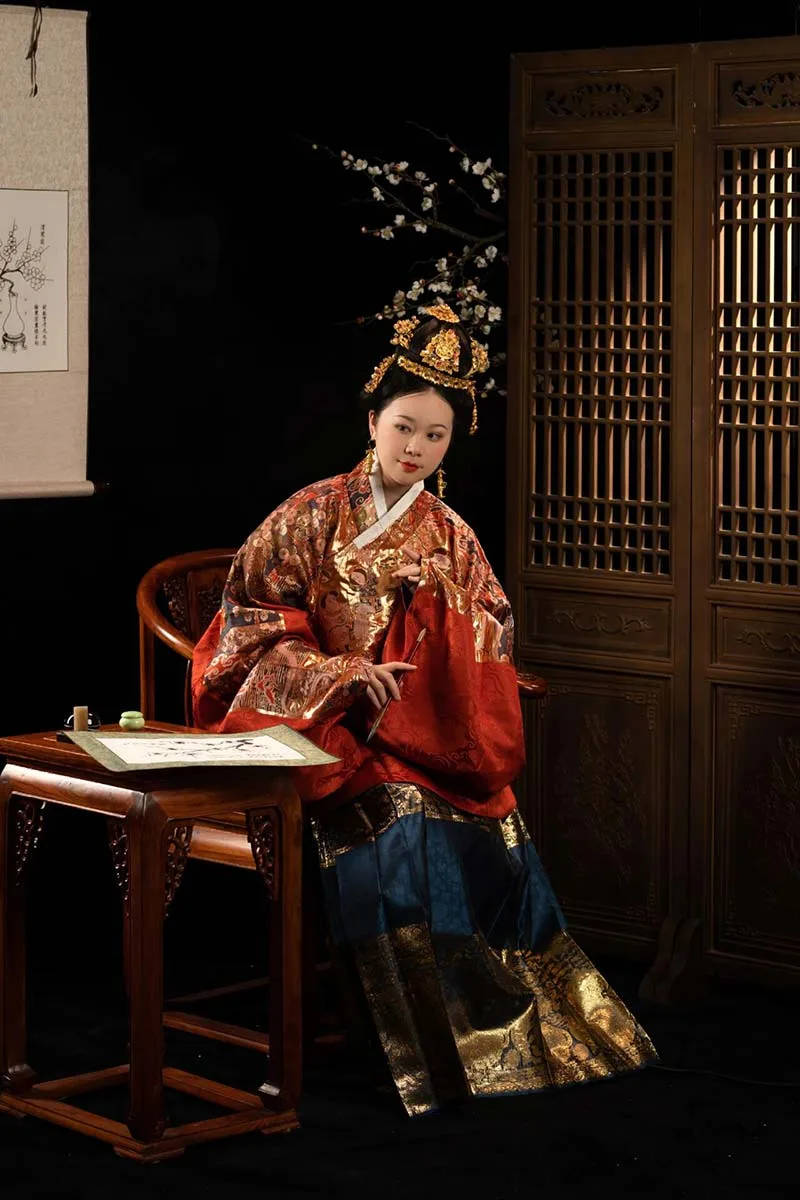
The mamian skirt is a type of lower garment that evolved from ancient hufu (Hu-style attire). It originated during the Song and Liao dynasties and flourished in the Ming and Qing periods.
In A Comprehensive History of Chinese Costume, the mamian skirt is described as: “pleated on both sides, with decorative panels at the front and back, topped with a waistband and ties.” From this, we can see that the skirt is mainly composed of four parts: the skirt doors (panels), skirt links, skirt sides, and the waistband. In total, it features four overlapping panels at the front and back—outer panels with elaborate decoration and inner ones with little or none. The sides are pleated, while the waistband is often made of white fabric, symbolizing lifelong harmony, and fastened with ties or buttons.
The mamian skirt is made from multiple panels sewn together. To fit the waist, pleats are added along the sides, while the overlapping central panels create a smooth, flat surface. The overall shape is trapezoidal—narrow at the top and wide at the bottom. The overlapping panels in front form what is called the “front mamian,” and once the skirt is wrapped around the body, the panels overlap again at the back, creating the “back mamian.”
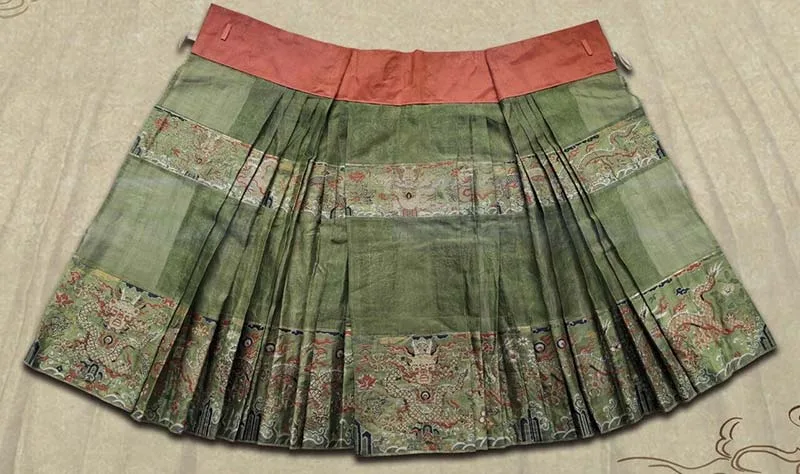
So why is it called a “mamian” skirt?
The term does not actually refer to the animal “horse.” Instead, it comes from the resemblance to an ancient military fortification known as mamian (originally written as māmian, meaning “code-face”). These watchtowers featured protruding rectangular facades with defensive walls on both sides that rose and fell like pleats. The smooth, flat surface of the tower’s facade resembled the skirt’s overlapping front panels, and over time the name “mamian” (马面) became interchangeable with “mamian” (码面), giving the skirt its name.
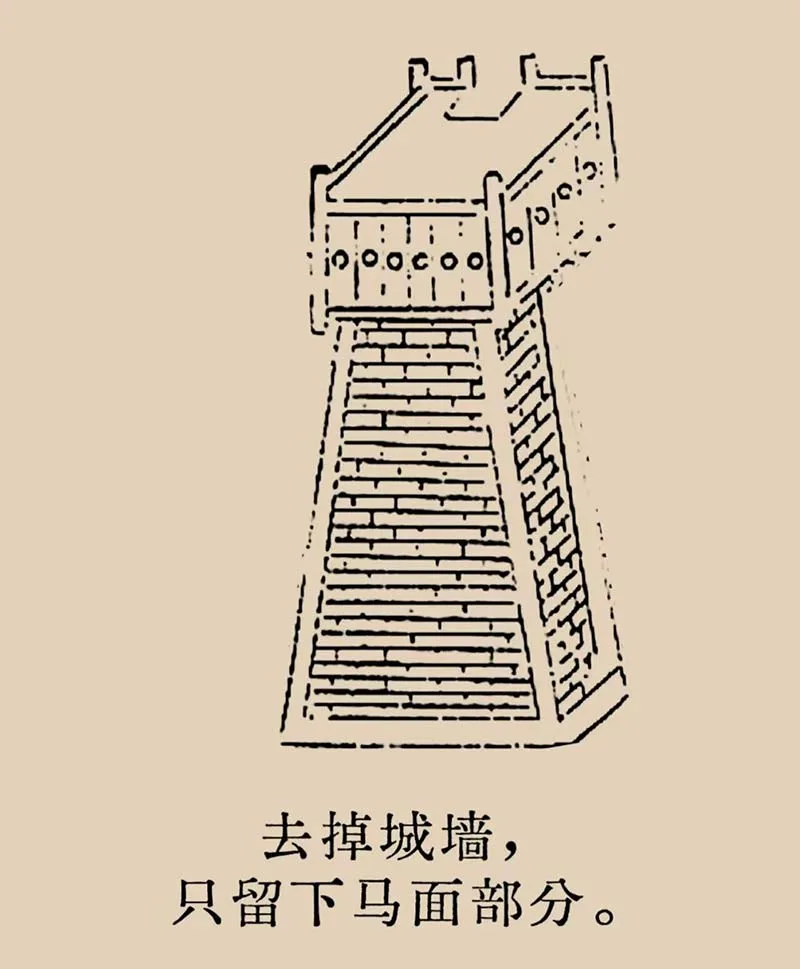
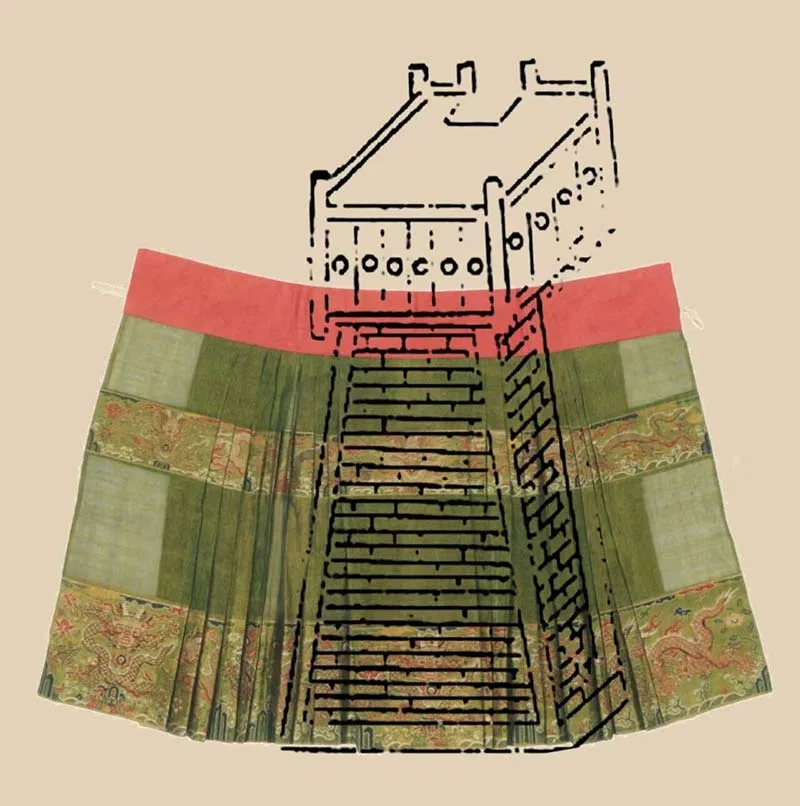
The prototype of the mamian skirt can be traced back to the swirling skirt (xuanqun) of the Song Dynasty. Its structure was relatively simple, originally designed as a practical garment for lower-class women to ride donkeys with ease. Before long, however, it gained popularity among the upper classes and even within the royal court.
Through the economic exchanges and cultural interactions among different ethnic groups during the Liao, Jin, and Yuan dynasties, the swirling skirt gradually evolved in the Ming Dynasty into a new form—the mamian skirt.
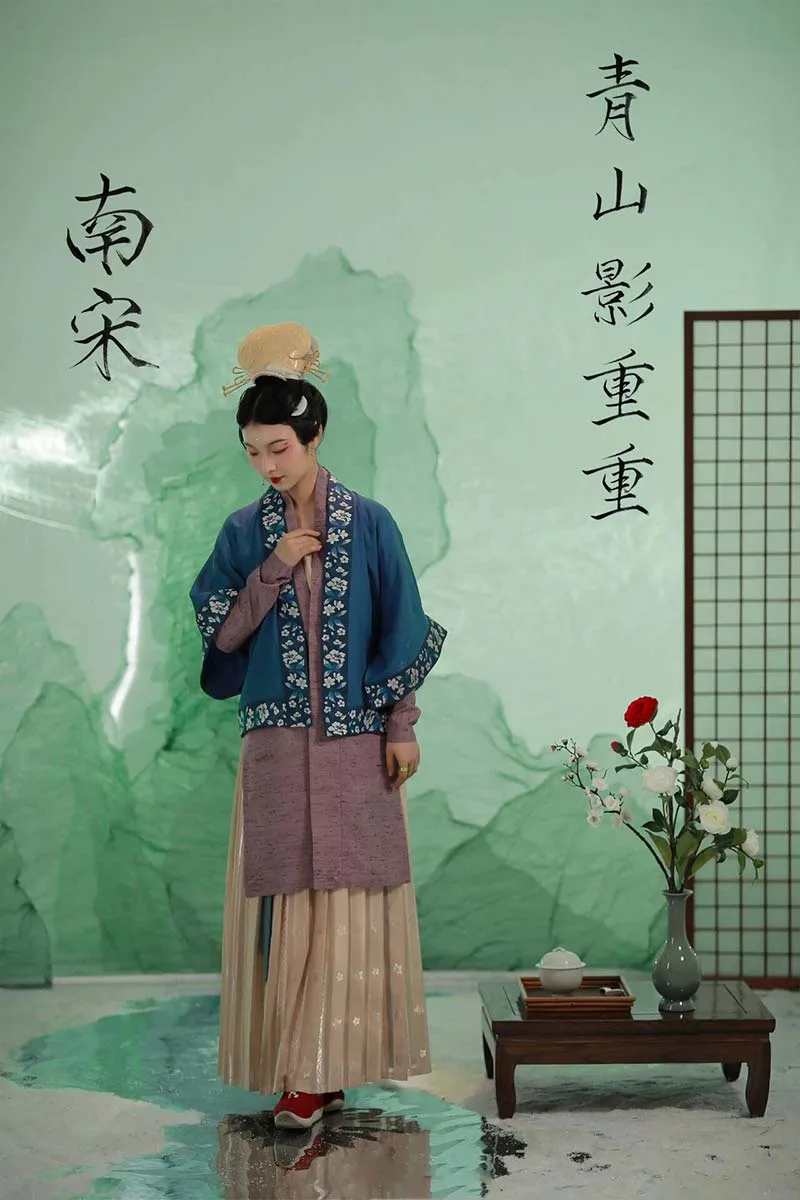
In the Ming Dynasty, the mamian skirt had a relatively simple structure, with pleats on both sides designed primarily for comfort. As a result, its decorative style tended toward fresh elegance. By the Qing Dynasty, Han women continued the Ming-style design, but the decoration of the mamian panels and skirt hems became more intricate. The pleats were finer and often edged with trim, giving rise to various styles such as the hundred-pleat skirt, lamgan skirt, and phoenix-tail skirt.
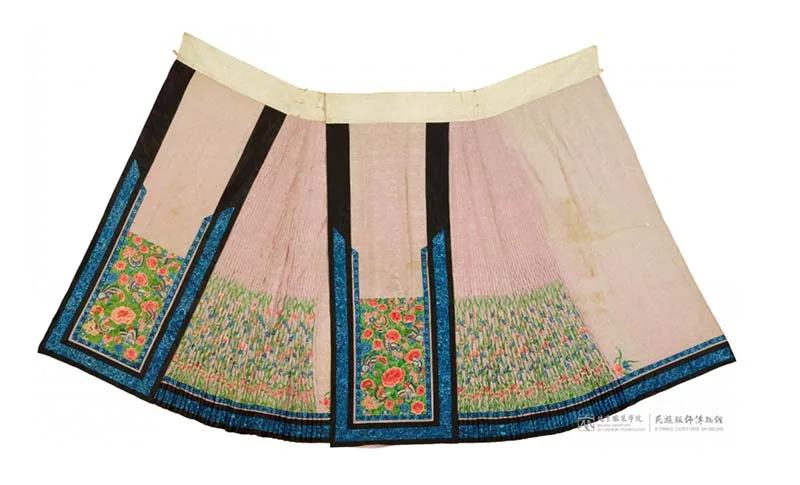
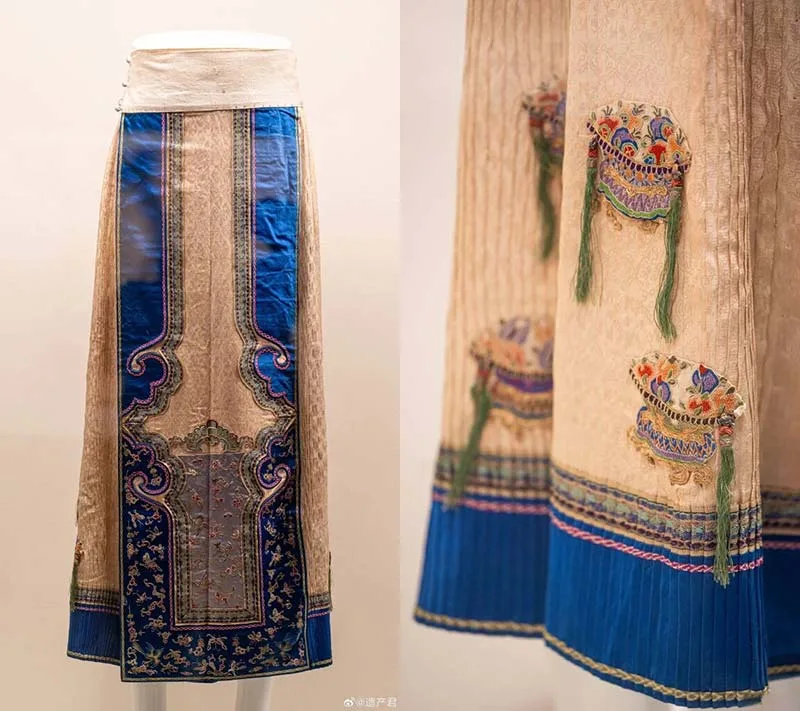
Pleats are one of the most distinctive features of the mamian skirt, with historical examples featuring up to a hundred pleats. In the Ming Dynasty, the skirt was made by folding rectangular fabric into pleats, which were left partially open from the waistband to the hem—known as “living pleats”. The pleats were pressed from the front and back panels toward the sides of the body, a style called “顺风褶” (wind-following pleats). When the wearer walked, the skirt flared at the hem, and the pleats moved fluidly, folding and unfolding like rippling water, creating a graceful and lively effect.
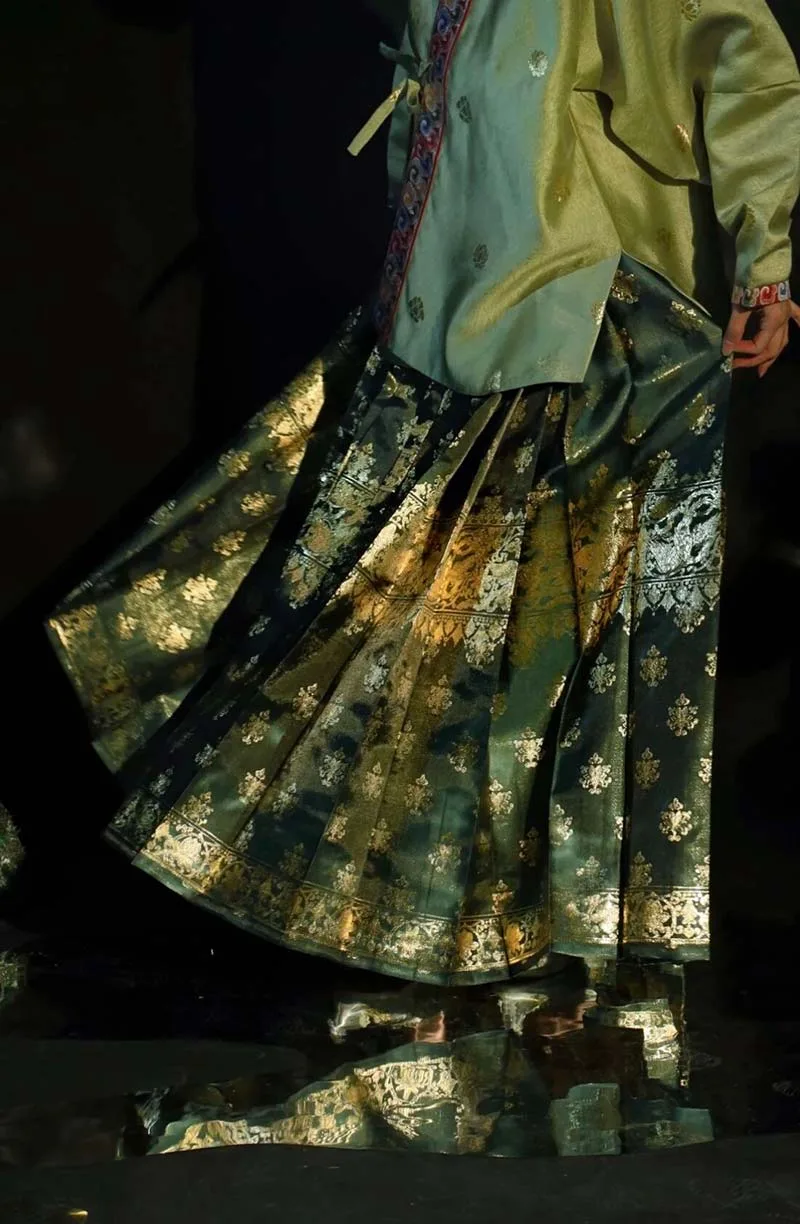
Fit for both the palace and the home, the mamian skirt embodies the craftsmanship of the ancients, with its refined beauty reflected in the intricate patterns adorning the fabric.
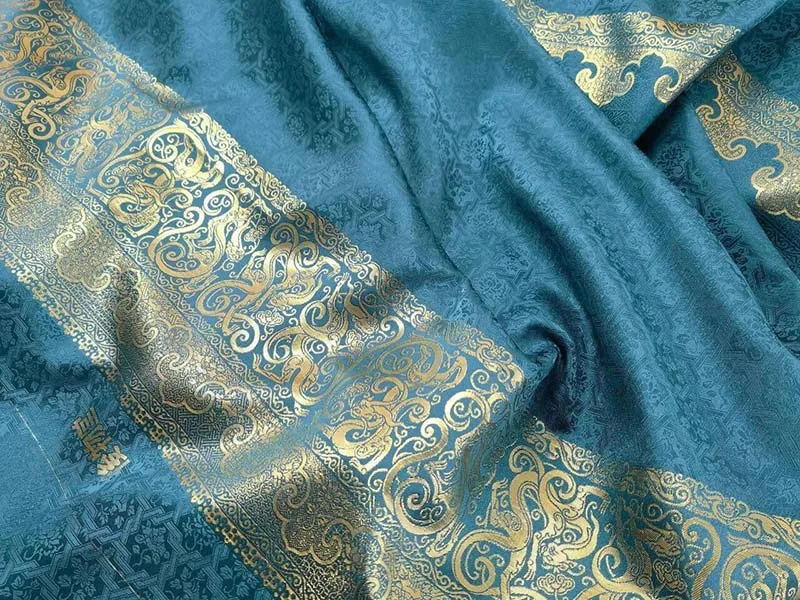
The decorative patterns of the mamian skirt are primarily concentrated along the hem. The designs are intricate at the bottom and gradually simplify as they move upward. These patterns can be broadly categorized into two types: standalone embroidered motifs and large areas of continuous embroidery.
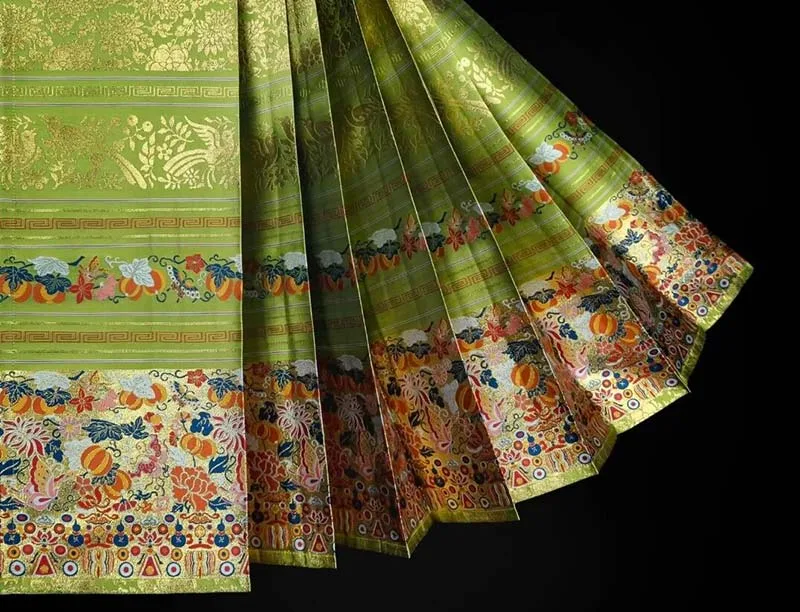
There is a renowned Ming Dynasty mamian skirt, often regarded as the benchmark of its kind, known as the “Zhuanghua Mamian Skirt.” Its surface is adorned with a variety of decorative motifs: the upper section features gold-thread woven flowering vine patterns representing the four seasons, while the lower section has three skirt panels, from top to bottom displaying gold-thread phoenix motifs, huazhai patterns, and bell-and-feather designs.
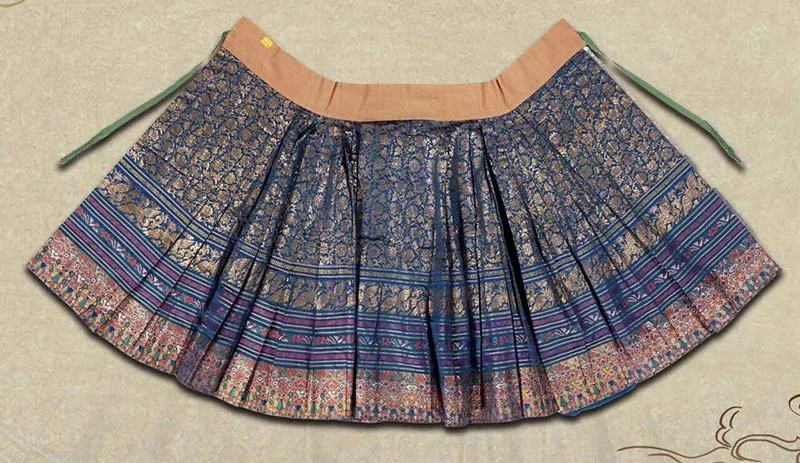
The decorative satin used for this mamian skirt is one of the most intricate varieties of Nanjing Yunjin brocade, representing the pinnacle of Chinese silk craftsmanship, and it still cannot be replicated by machines. Weaving a single piece requires two artisans working simultaneously—one controlling the pattern, the other managing the colors. Even so, they can produce only 5 to 6 centimeters per day at most.
If you’re passionate about traditional Chinese clothing, you can explore our Hanfu collections online to discover a variety of classic designs, from elegant mamian skirts to Ming dynasty robes. Each piece reflects the intricate craftsmanship and timeless beauty of Hanfu, perfect for festivals, cultural events, or everyday wear.
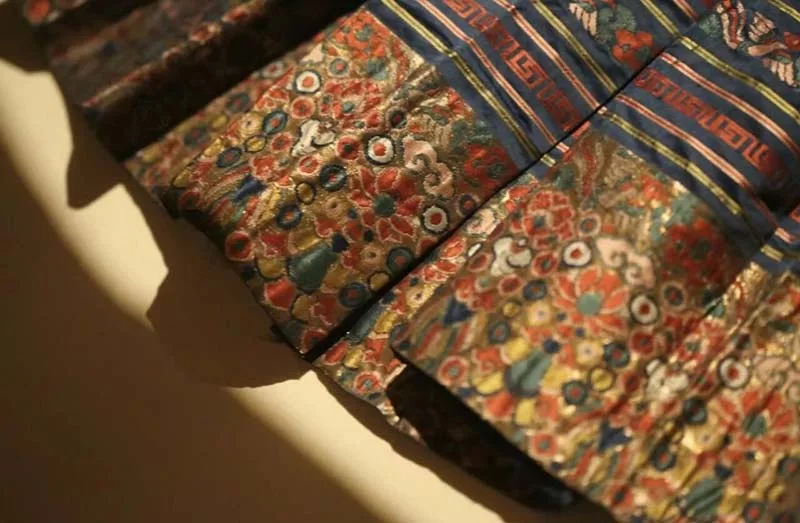
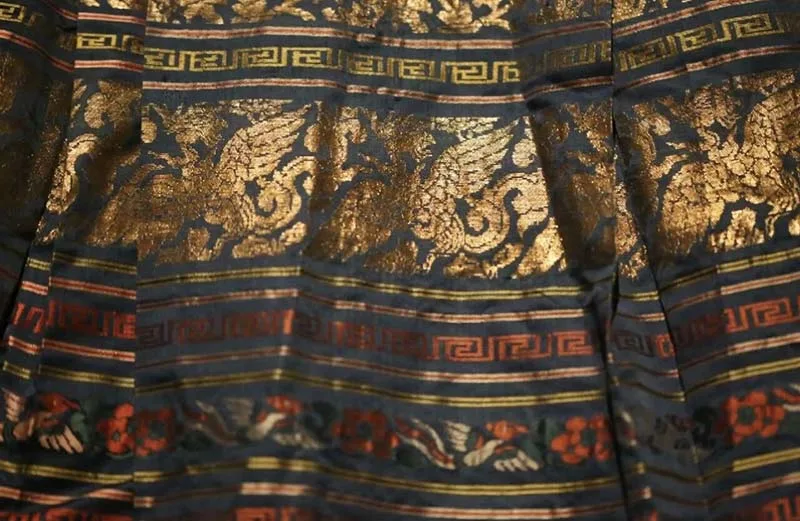
Just as there are resplendent Zhuanghua mamian skirts, there are also delicate and elegant embroidered mamian skirts. The white jacquard gauze skirt embroidered with birds and flowers is another classic piece of Ming-style Hanfu. In terms of structure, material, and aesthetics, it perfectly reflects the style of mamian skirts from the mid-to-late Ming Dynasty.
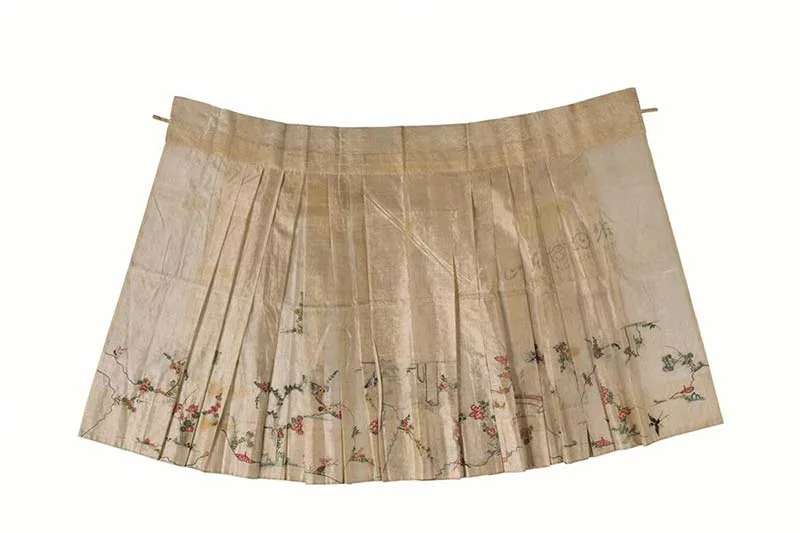
Jacquard gauze was a commonly used fabric in Ming Dynasty clothing. It is relatively crisp, and its delicate patterns are visible when light passes through. Walking in a gauze garment under the sun evokes the poetic imagery of “flowers casting layered shadows in the bright daylight.” When a gentle breeze flows, the skirt sways lightly, as if floating on the wind. On this particular floral-and-bird skirt, the subtle woven pattern features plum branches, harmonizing beautifully with the snow-white fabric of the skirt.
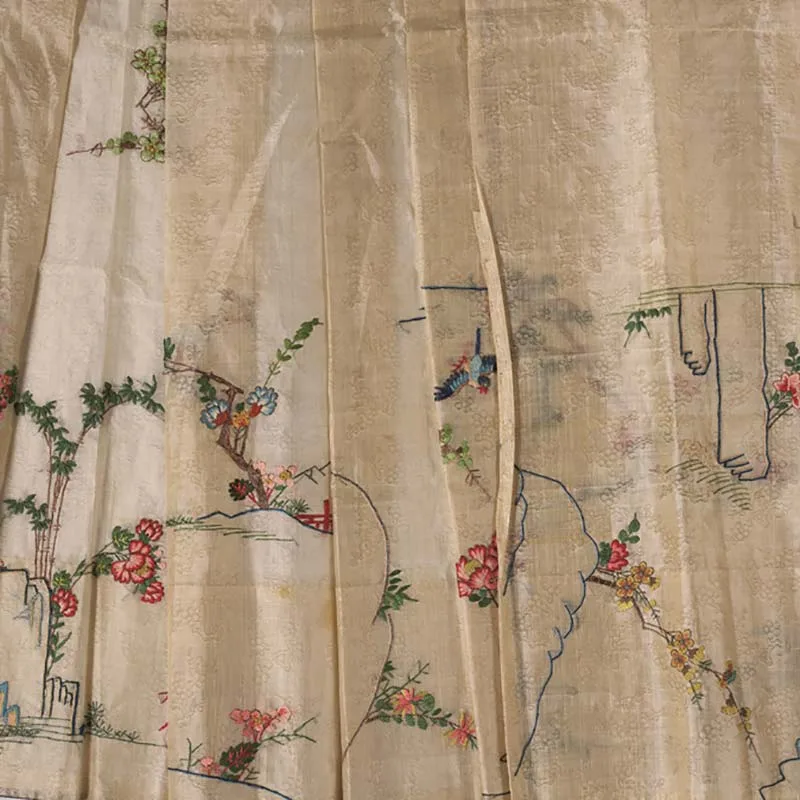
The mamian skirt features a wide variety of decorative motifs, each carrying its own symbolic meaning. Many are auspicious patterns, such as the “Three Friends of Winter”—pine, bamboo, and plum—or “Year after Year with Surplus”, combining lotus flowers and fish. Other commonly used motifs include auspicious clouds, swastikas, ruyi scepters, dragons and phoenixes, a hundred flowers, a hundred animals, the Eight Immortals, the Eight Treasures, and the Eight Auspicious Symbols, all reflecting wishes for good fortune and longevity.
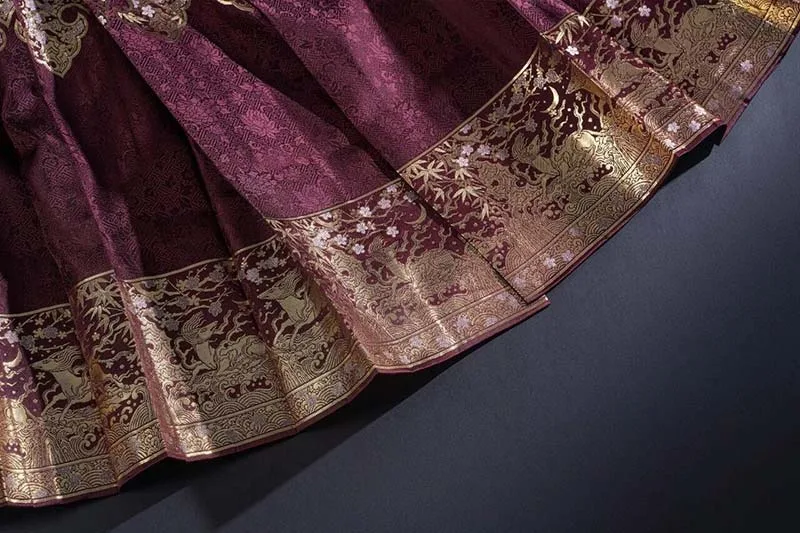
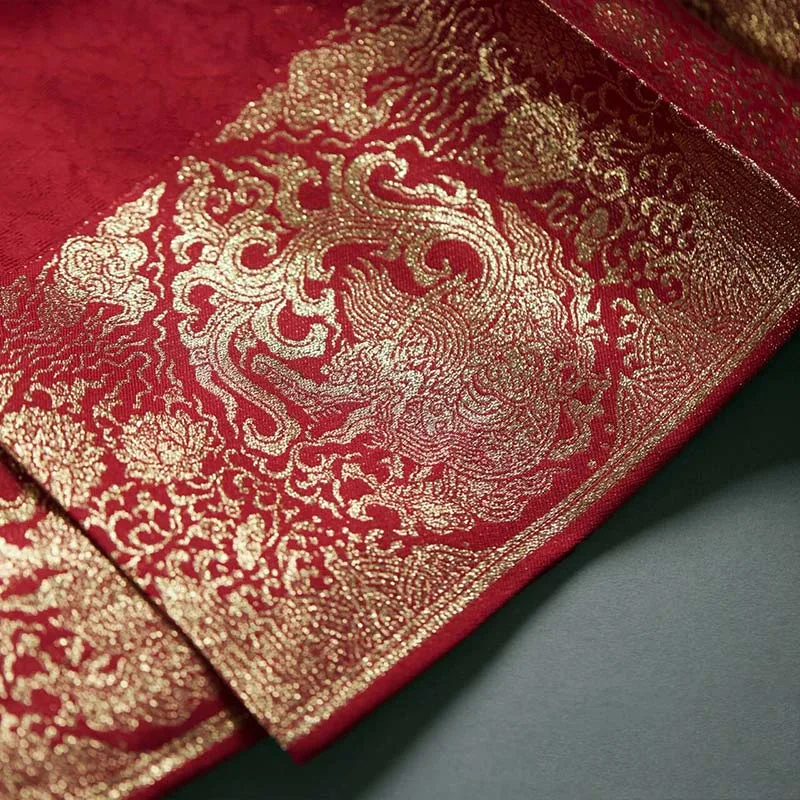
The colorful patterns on the mamian skirt reflect people’s hopes for life and brighten the wearer’s everyday experience, embodying a kind of practical romanticism.
In the past, the Hanfu community valued strict adherence to historical accuracy, following established Hanfu etiquette: when wearing Hanfu in public, one was expected to style hair and makeup like the ancients and dress in a complete, properly coordinated set. Mixing styles from different dynasties or combining modern and traditional elements was generally frowned upon.
The rise of the mamian skirt has, to some extent, rewritten these traditional rules. Boosted by celebrity influence and cultural promotion, it has repeatedly sparked public interest, creating opportunities for the mamian skirt to enter everyday life.
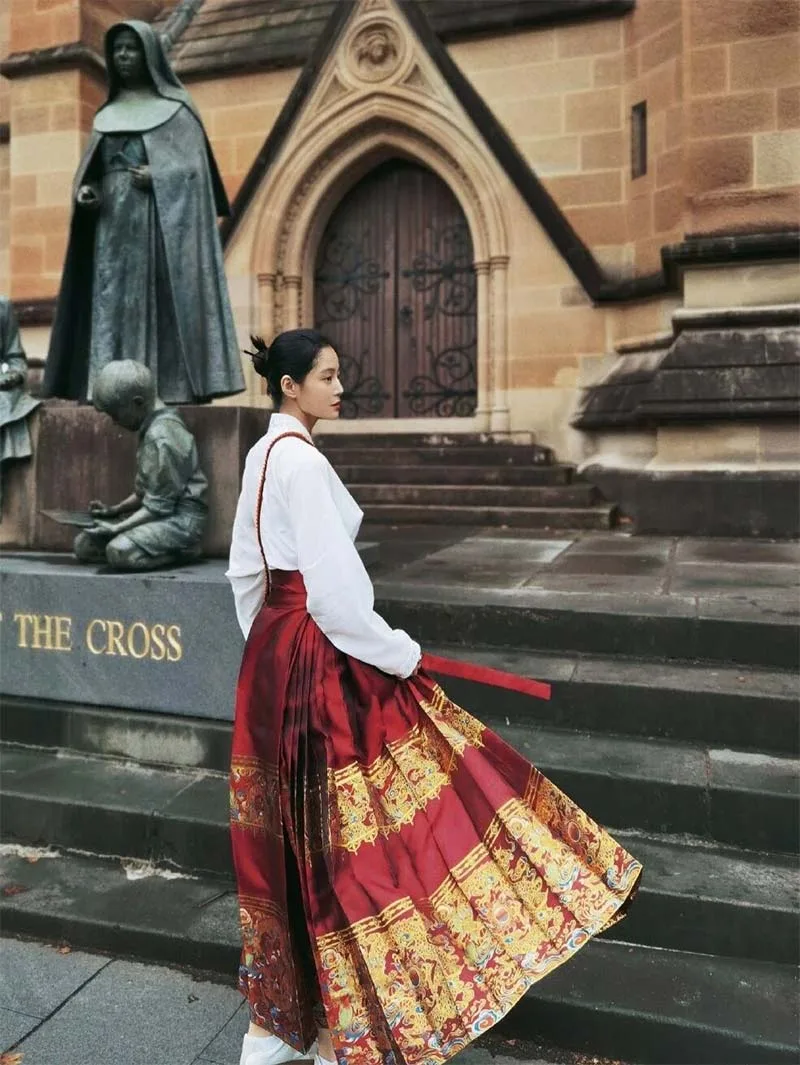
Everyday hair and makeup rarely allow one to carry a full, formal Hanfu outfit, but the mamian skirt strikes the perfect balance between traditional cultural elements and practicality. Beyond pairing with matching traditional garments, the mamian skirt can be effortlessly combined with modern clothing such as shirts, T-shirts, sweaters, or coats without feeling out of place in daily life. Its refined hem draws the eye and adds elegance, yet never appears overly flashy or jarring.
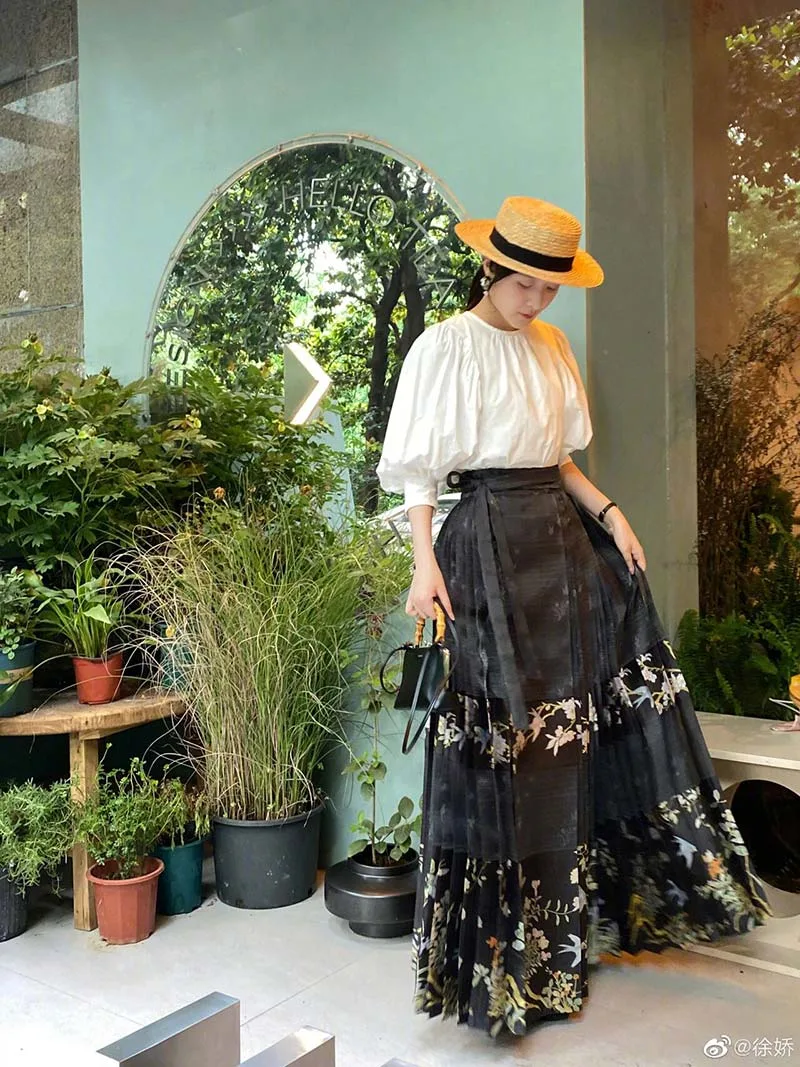
Moreover, the cut and wearing style of the mamian skirt is very flattering for different body types. Hanfu skirts are generally wrapped around the body, and the mamian skirt can be worn either front-to-back or back-to-front, offering flexibility and comfort.
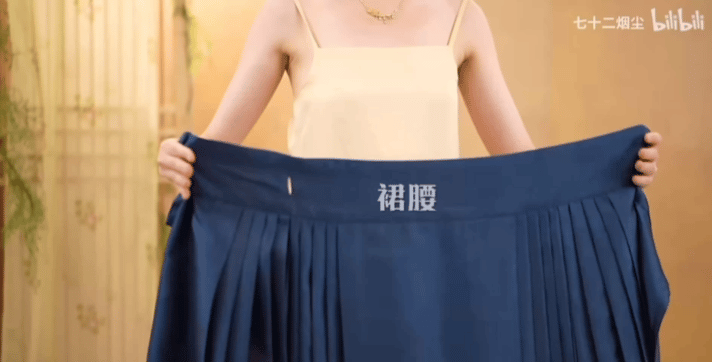
First, thread one of the wrapping ties through the eyelets at the waistband of the skirt.
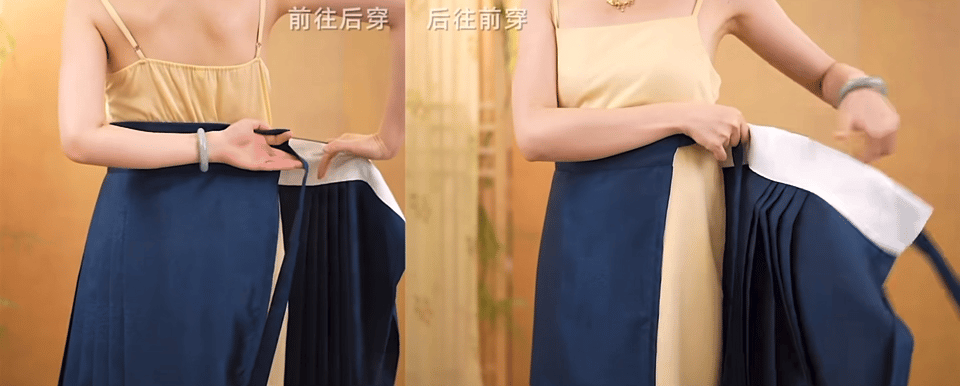
Wrap the other tie around the waist and knot it to secure the waistband and prevent the skirt from slipping.
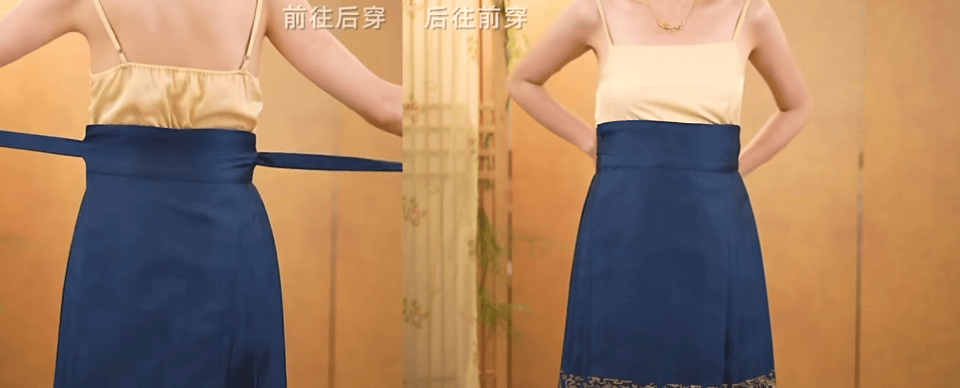
For mamian skirts without eyelets, after wrapping the two panels around the body, slightly lift the inner panel and pull the tie out.

Fold a corner of the waistband downward, wrap the tie around, and knot it to secure.
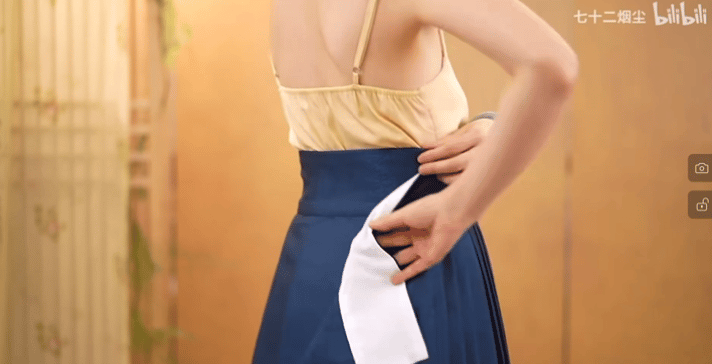
Once worn properly, the smooth panels at the front and back overlap neatly.
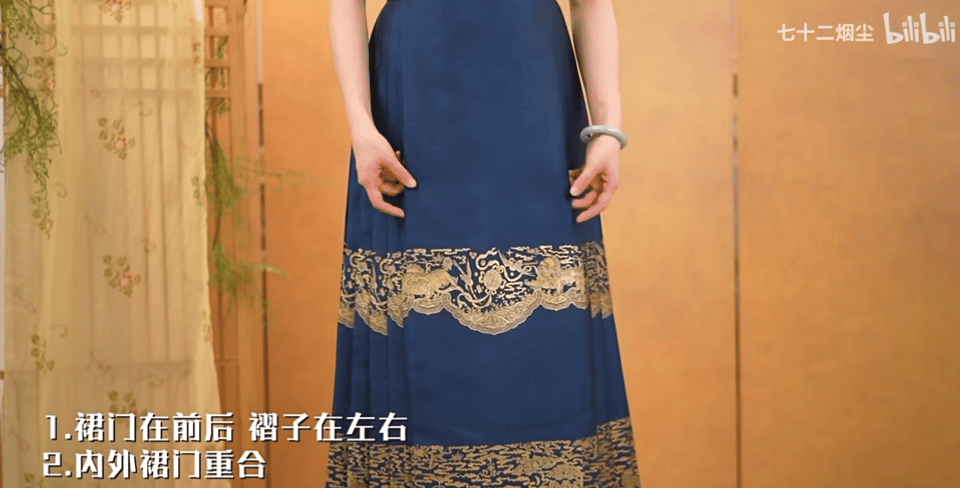
Traditionally, the mamian skirt is worn with the top left untucked, creating a flattering, slimming effect. The pleats on both sides of the skirt also help to disguise the hips.
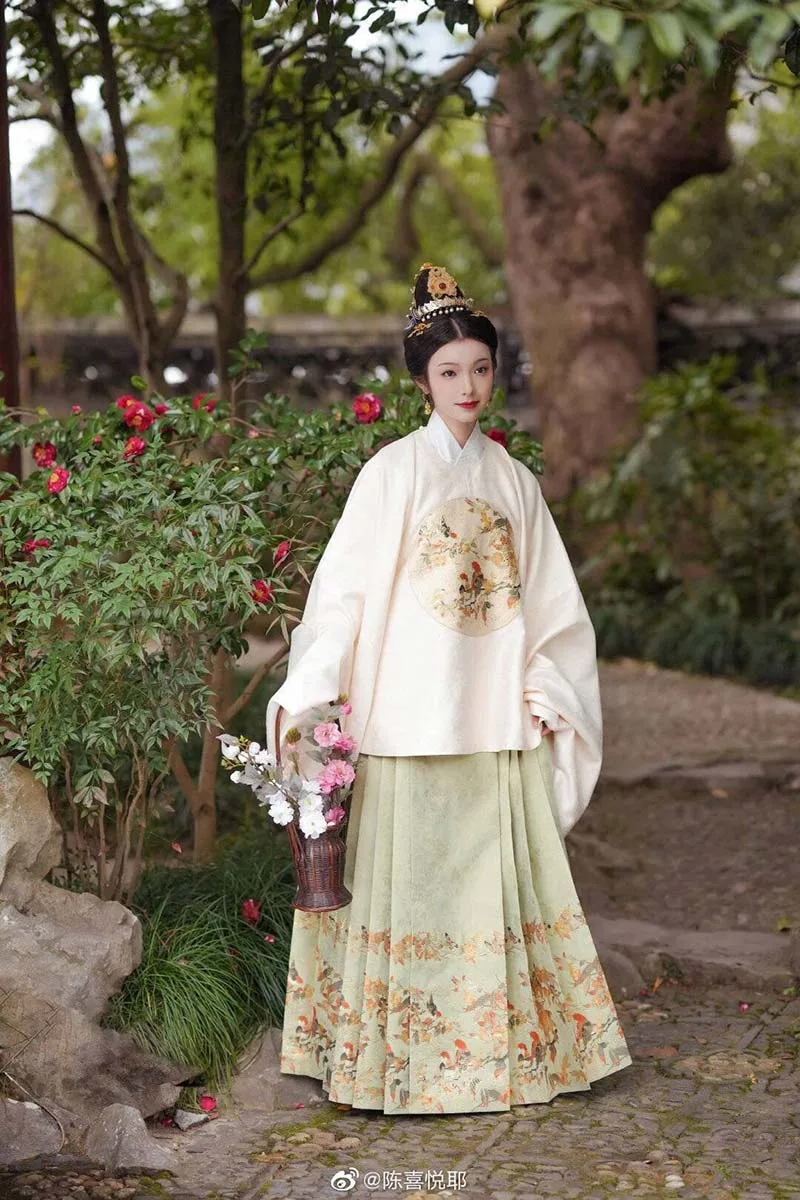
When mixed with modern clothing, if you choose to tuck the top into the skirt, a waistband or belt can be added to adjust body proportions.
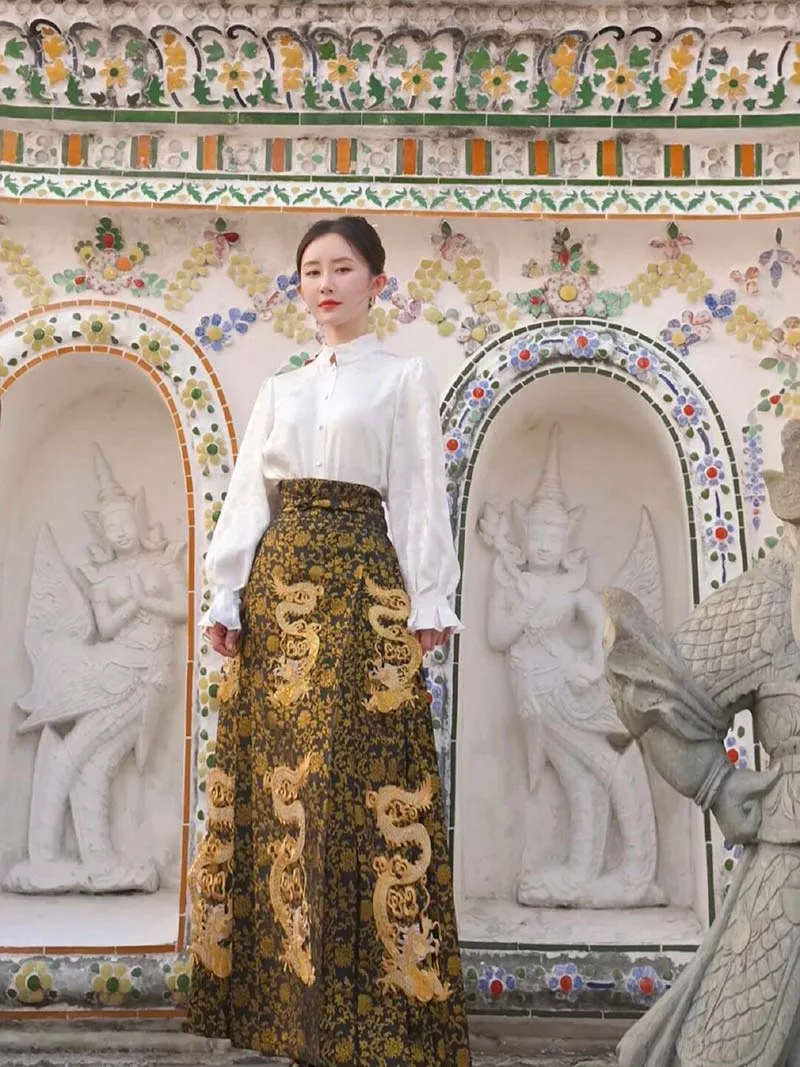
As one of the main skirt styles in traditional Han women’s ruqun attire and a typical skirt design for Ming and Qing dynasty women, the mamian skirt embodies an important aesthetic concept in ancient Chinese women’s lives: light in structure, rich in decoration, subtly natural, and expressive of the body in a way reflecting Zen-inspired beauty. It has left a lasting historical and cultural imprint that continues to resonate with contemporary tastes.
From museum artifacts and textbook illustrations to garments worn in daily life, the mamian skirt’s rise in popularity represents not only a microcosm of the revival of Chinese civilization but also a vivid demonstration of Hanfu’s living vitality. Through repeated wearing, sharing, and discussion, it inspires ideas on how to best preserve and pass on this tradition.
The revival of any traditional culture relies on the participation of contemporary people. While the structure of traditional clothing captures the aesthetic sensibilities of the ancients, the true brilliance of their wisdom lies in designing garments that allow for transformation and adaptation to new life.
The resurgence of the mamian skirt reminds us that one of the best ways to safeguard and carry forward Hanfu is simply to wear it confidently and gracefully in everyday life.
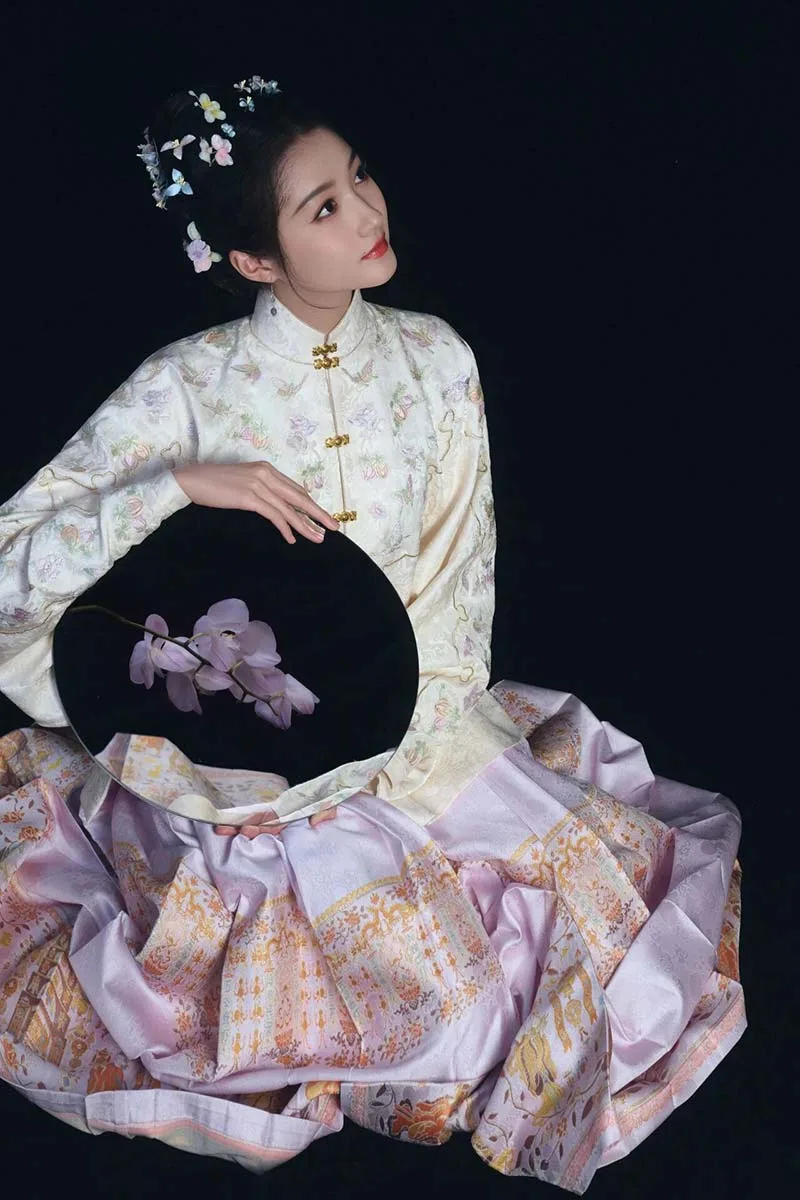
Discover the timeless beauty of traditional Chinese fashion with the mamian skirt. From Ming and Qing dynasty designs to modern adaptations, this skirt showcases exquisite pleats, intricate embroidery, and rich cultural symbolism, making it a perfect introduction to the artistry of Hanfu.
